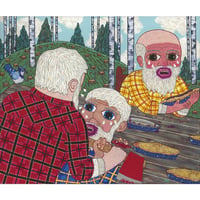The Pie Eating Contest 20 x 24" Original Painting
Original 20x24" Painting. Acrylic on Canvas
While difficult to fathom today - with most Americans understanding currants and gooseberries to be intermediary hosts of white pine blister rust - before the 1911 federal ban on Ribes, there was substantial misinformation regarding the cause of the fungus that ravaged the nation’s high-elevation lumber supply.
Gooseberries were correctly identified as hosts of the dreaded white pine blister rust from the start, but a lack of understanding the difference between the genus Ribes (gooseberries & currants) and the genus Rubus (blackberries, raspberries, etc.) resulted in an unnecessary attempt by those with lumber interests and investments to eradicate any fruit referred to as a “berry” across North America.
Excessive forced berry harvests in the early 20th century flung timber regions into a decadent “pie frenzy” as gluttonous berry pie consumption was viewed as a patriotic means of combating white pine blister rust, thus cementing the pie-eating contest as a traditional Independence Day activity.
A favorite pie amongst the woodsmen was a blackberry, blueberry and raspberry pie with lemon juice and anise extract served room temperature of course, since hot pie is not an acceptable culinary practice as cooling a freshly baked pie to room/campsite temperature is an essential part of the process, allowing the filling to congeal properly. Reheating a finished pie is an appalling procedure, entirely undermining the pie craft unless one is simply reheating apple pie to melt a slice of cheddar cheese on top.
After a group of lumberjacks murdered a family of five for growing dewberries on their farm in 1909, President Taft’s administration distributed pamphlets outlining key genus, subgenus and species of the kingdom Plantae in the United States and properly attributed white pine blister rust solely to the genus Ribes. Gone were the days of forced Rubus harvests, and to this day, many “household berries” are staples of American culinary values.
